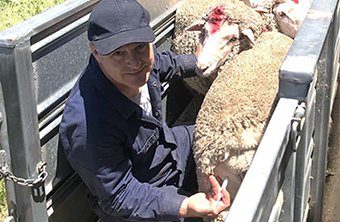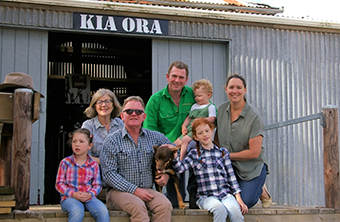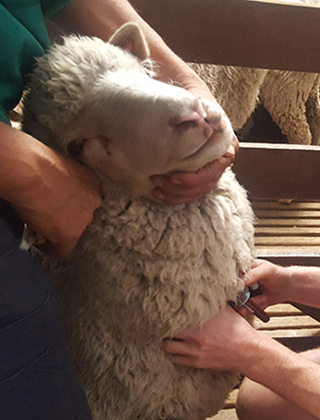Anaesthetic and analgesic treatments deliver on-the-ground benefits
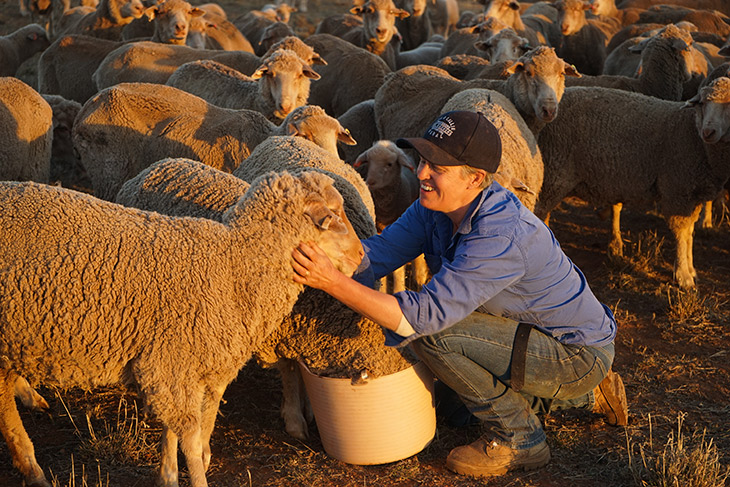
Woolgrowers Audrey Bird of Western Australia and Jodie Green of NSW believe whole-heartedly in the benefits of effective and practical anaesthetic and analgesic treatments during lamb marking.
Jodie Green with her sheep at Boree Creek in NSW.
Woolgrowers Audrey Bird of Western Australia and Jodie Green of NSW believe whole-heartedly in the benefits of effective and practical anaesthetic and analgesic treatments during lamb marking.
Globally, Australian Merino woolgrowers are leaders in adopting anaesthetic and analgesic treatments for husbandry procedures. Tri-Solfen®, a local anaesthetic, was registered in 2007, while the non-steroidal anti-inflammatory drugs (NSAIDs) Metacam® and Buccalgesic® were registered in 2016 and 2017 respectively. Numnuts®, a handheld device that delivers a local anaesthetic (NumOcaine®) for ring castration and tail docking by rings, was launched in 2019.
On-farm adoption of these analgesic and anaesthetic options has been rapid.
For Jodie and Andrew Green at Boree Creek in the Riverina region of NSW, the incorporation of local anaesthetic into their lamb marking procedure, through the Numnuts device, is the next step in managing the health and wellbeing of offspring from their 6,500 ewe flock.
“Our operation is focused on breeding sheep that truly suit their environment; that is the most responsible thing to do,” Jodie explained. “Our sheep have soft, thin skin, they repel water and dust and thrive in the climate we expect them to live in.”
Although they have worked hard to develop sheep that thrive in their environment, they still need to undertake surgical husbandry practices, such as marking and tail docking.
“We ceased mulesing during 2006, but only introduced an anaesthetic several years ago,” Jodie said. “We stopped using the hot iron about eight years ago and now use an elastrator for tails and testicles, with the addition of a local anaesthetic to minimise stress during and after the process.”
According to Jodie, the local anaesthetic delivered through the handheld Numnuts device provides sufficient relief to allow the marked lambs to mother up and become settled back in their paddocks by the time the impact of the analgesia wears off.
“Our ideal approach is to set up portable yards in the paddock and bring each mob to the yards so we can mark straight back into the paddock,” Jodie said.
Jodie believes the anaesthetic makes a difference both to the mothering up process immediately after marking, but also when returning the flock to its paddock.
“If you miss a lamb with the device at the end of a batch of anaesthetic, you notice the difference,” Jodie said. “The untreated lamb will come out of the cradle and sulk while the treated lambs land on the ground and head out to the ewes.”
Jodie describes moving the mob back to the paddock after marking to be as stress free as bringing them into the yards before marking.
While producers might be put off by the additional cost and time associated with providing an anaesthetic during marking, Jodie and Andrew have calculated the investment of 76c per ewe lamb and $1.50 per ram lamb is more than worthwhile and indicated that using the device only increases the process of marking by about two seconds per animal.
“You need to be committed to maximising animal welfare and focus less on the cost,” Jodie said. “It’s easy to maintain our commitment when our lambs mother up immediately and we see no check in lamb growth after marking, which is extraordinary.”
Animal welfare a no brainer
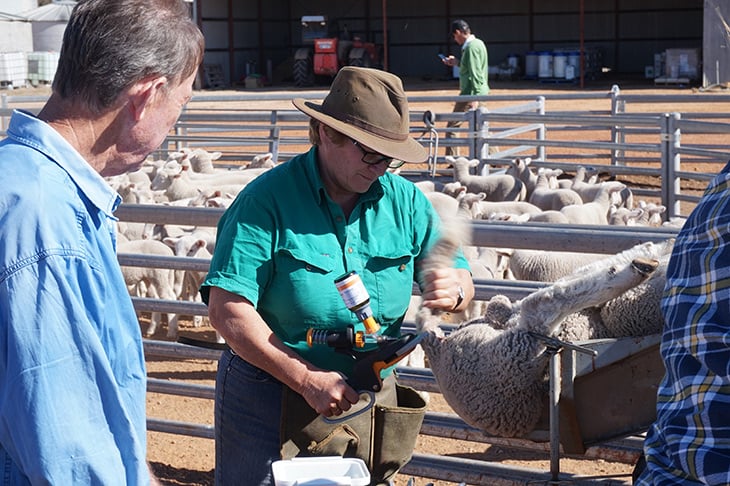
Audrey Bird using Numnuts for marking her sheep at Wickepin in WA. PHOTOS: Numnuts
On the other side of the country, at Wickepin 2.5 hours south-east of Perth, Audrey Bird is running a 1,700 head self-replacing Merino flock as part of a 4,300ha mixed farming operation.
Audrey has long been keen to minimise stress across her sheep husbandry activities, especially during mulesing and marking.
“Sheep are valuable and it is worth ensuring you do the best you can do,” Audrey said. “Anything you can do to minimise the animal set-backs is well worth pursuing.”
Audrey has been using Tri-Solfen for the mulesing operation since it was first available and combines this with Buccalgesic and NumOcaine to optimise pain management and lamb recovery at marking. She believes the use of anaesthetics (like Tri-Solfen and NumOcaine) and analgesics (such as Buccalgesic) is a “no brainer”.
“I got to know about Buccalgesic through my niece, who is a vet,” Audrey said. “I tried that and thought it was relatively cheap for the benefits it gave our business. It is long acting and even after it’s worn off, the impact of lower stress during marking appears to have benefits for several days afterwards.”
Audrey also followed the development of the Numnuts system since it was first mooted and was one of the first producers in WA to use it, believing it has its own special niche.
“When the lambs come off the cradle without the anaesthetic, the wethers tend to be impacted,” Audrey conceded. “The NumOcaine acts immediately and we use the Numnuts system on the testicles and the tails of our prime lambs.”
The combination of both Tri-Solfen® or NumOcaine® with a meloxicam product provides the most effective pain relief and gives the lamb the best chance of recovering faster, addressing both the immediate pain and distress and any pain that might occur during the healing process, as well as reducing the possibility of infection.
As with Jodie’s experience, Audrey said the lambs mother up immediately out of the cradle and run out of the yards better.
“We have reduced the number of lambs sitting or lying down and squirming around by 90 per cent. If lambs can mother up and get a drink and walk behind the mothers back to the paddock it is a lot better for the lamb and a lot better for us.”
As far as mulesing goes, Audrey is in the process of phasing out this operation through a dedicated breeding objective. In the meantime, she makes sure operators disinfect their equipment between lambs and focus on animal welfare above throughput. Earmarking tools are also disinfected regularly and replaced every few years.
Communicating her expectations to livestock contractors is important to Audrey.
“We process 800–900 Merino lambs a day,” Audrey said. “But we pay per hour rather than per lamb and we supply an extra person as well as the contracting team to help things move smoothly and reduce the focus on throughput above animal welfare.”
It is the peace of mind that is important to Audrey when it comes to using anaesthetics and analgesics.
“It costs about $2.30/hd for all three treatments, and with current sheep and lamb prices I believe it’s a good investment for our business,” Audrey said.
“Although the productivity gain is hard to calculate, we tick the animal welfare box and there could be more premium benefits, but we haven’t looked into it.
“As an industry, we need to look at consumer preferences when it comes to managing our animals — look at the benefits rather than the hurdles.”
More information:
For further information and resources about using analgesia and anaesthesia when lamb marking, head to www.wool.com/aa. Also available on the page is a recording of a very popular 50-minute AWI webinar on lamb marking by respected veterinarian and sheep consultant, Dr Tim Gole.
Summary of available anaesthetics and analgesics
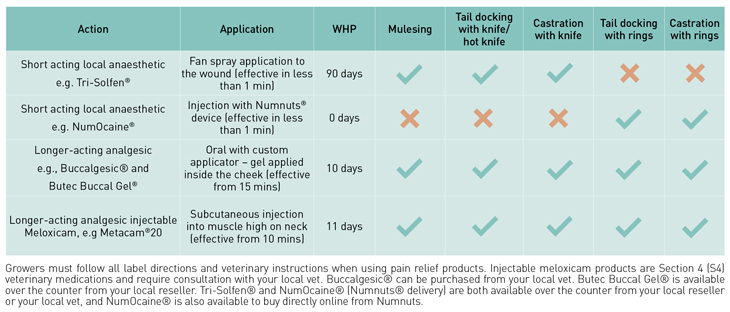
Lamb marking training guide
This training guide is designed to assist woolgrowers and their contractors perform best practice lamb marking and mulesing procedures with the utmost care and attention to ensure the best short- and long-term welfare outcomes for the animal.
Published in June 2020, the 80-page guide was developed by AWI in partnership with WoolProducers Australia and the Livestock Contractors Association. It includes sections on:
- Overview of lamb marking
- Work health and safety
- Legislation and Codes of Practice
- Preparation and planning
- Lamb marking and mulesing equipment
- Chemical and animal health product use (disinfectants, insecticides and analgesia/anaesthetics)
- Lamb marking and mulesing procedures
- References
- Chapters from the Australian Animal Welfare Standards and Guidelines for Sheep relating to responsibilities, tail docking, castration and mulesing.
More information: Access the guide at www.wool.com/marking-guide
This article appeared in the March 2021 edition of AWI’s Beyond the Bale magazine. Reproduction of the article is encouraged, however prior permission must be obtained from the Editor.






